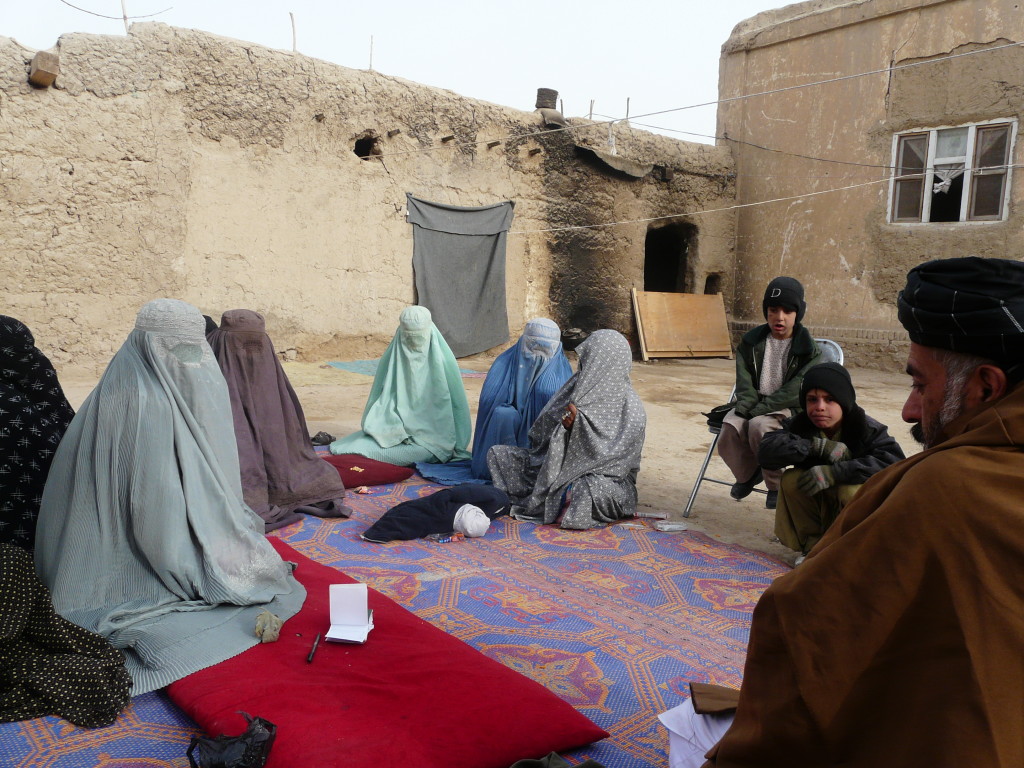
Women of Hutal village discuss building a women’s center with the Maiwand District Governor – courtesy of Cythia Hogle
WASHINGTON — In a rural village southwest of Kandahar, a local police force operates out of a posh modern facility surrounded by mud-brick buildings.
Three years ago it was built as a cooperative US-Afghan venture to be a focal point for the advancement of women in the community.
The Malalai Anaa Center for Women and School for Girls in Hutal village was the face of success for American policy in Afghanistan: a collaborative effort by the US military, the US Agency for International Development, NGOs and local leaders and laborers. It would provide vocational training, a girls’ school and a water source for the women of Maiwand District. It would be a prime example of the advances women have been able to make in Afghanistan since coalition forces moved in.
Except, now it’s gone.
As soon as US forces turned over the area to the Afghan National Security Forces in 2013, local police closed the center, ran the women out and commandeered the building for their own headquarters.
“We could have predicted it,” recalled Cynthia Hogle, a cultural adviser with the US Army’s Human Terrain System who coordinated the project.
“We didn’t have any plan for sustainability and relied on the [Afghan] government, who made empty promises” to continue supporting the center, she told Medill News by phone.
Advancing Afghan women’s rights has been a key US policy objective since 2001, when Congress passed the Afghan Women and Children Relief Act. Under the previous rule of the Taliban, women were banned from schools, work, health care and all manner of public life.
Significant gains have been made over the last 13 years. But some experts are worried that without sustainable support, those inroads will reverse as soon as US forces leave the country.
According to USAID, the agency primarily responsible for implementing US gender policy in Afghanistan, girls today comprise more than one-third of all school children. More than 40,000 women are enrolled in post-secondary education, and women now maintain an active and visible role in economic and political life, including holding 25 percent of the seats in the Afghan parliament.
Yet increasingly, those advocating for women’s rights in Afghanistan are subjected to violence and intimidation as well as government indifference, according to an Amnesty International report from April.
Throughout Afghanistan, the “common thread … is that the pattern of abuse against women human rights defenders is matched by the government’s systematic failure to provide an environment that protects them or to bring the perpetrators of abuses to justice,” the report claims.
Ill-conceived economic and political support from the international community makes the problem worse, AI says. Investment tends to be limited, focusing on short-term projects developed with little input from those who would benefit.
The US Special Inspector General for Afghanistan Reconstruction (SIGAR), the agency set up by Congress to oversee approximately $104 billion invested in the country for redevelopment, is also concerned. Last month, SIGAR released an inquiry letter into the joint US-Afghan Promoting Gender Equity in National Priority Programs (PROMOTE).
USAID’s flagship program for women’s empowerment in Afghanistan — and its largest in the world — plans to spend $416 million targeting 75,000 Afghan women ages 18 to 30 to become future political, business and civil society leaders.
But in the letter, SIGAR Inspector General John Sopko worried that “some very basic programmatic issues remain unresolved and that the Afghan women engaged in the program may be left without any tangible benefit upon completion.”
Donald Sampler, USAID’s assistant administrator for Afghanistan and Pakistan, acknowledged that the “context in which PROMOTE is being implemented is not an easy one,” but believes the program will be successful.
Sustainability will be achieved “by prioritizing local ownership of activities and employing Afghan organizations to undertake PROMOTE activities,” Sampler says.
Sopko, however, was unconvinced.
“SIGAR continues to have concerns about how USAID will implement the PROMOTE program, assess its outcomes, ensure its sustainability, and conduct oversight, concerns which are shared by other senior US and Afghan officials,” he said in an interview, adding that SIGAR will continue to monitor the program.
Even Afghanistan’s new first lady, Rula Ghani, was skeptical about the program in a speech last November.
“The immediate effect in Kabul [of PROMOTE] has been a flurry of NGOs, newly created or reconfigured with the view of attracting some of the windfalls of that budget,” Ghani said.
“I do hope that we are not going to fall again into the game of contracting and sub-contracting and the routine of workshops and training sessions generating a lot of certificates on paper and little else.”
Between 2011 and 2013, USAID spent almost $850 million on 17 women’s empowerment programs in Afghanistan, but were unable to demonstrate this money directly helped Afghan women, according to a December 2014 SIGAR audit.
Despite general improvements in the status of Afghan women, according to the report, there is “no comprehensive assessment available to confirm that these gains were the direct result of specific US efforts.”
The women of Hutal village might agree. The Malalai Anaa Center — named for a local heroine who led Pashtun tribesmen to successfully revolt against the British in 1880 — might soon be just a memory.
“Without the support of their government or the men in their community, all the work and progress will come to a halt and the hopes of the women will be dashed,” Hogle said.
“There are just too many challenges for them to overcome without some source of continuing support.”






